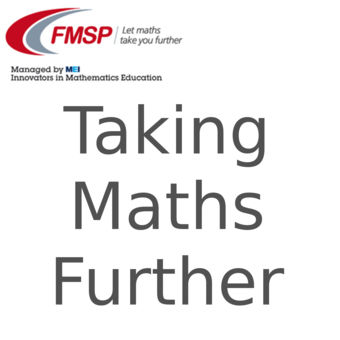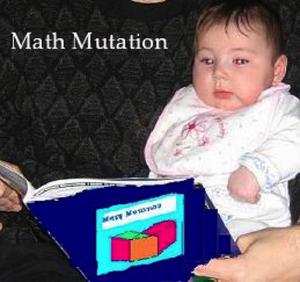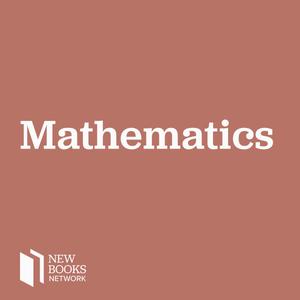
Taking Maths Further Podcast
Peter Rowlett and Katie Steckles
Talking to people who use maths in their work. Aiming to encourage further uptake of maths at A-level and beyond. brought to you by the Further Maths Support Programme. The FMSP supports students and teachers in England with mathematics, and you can find out more at furthermaths.org.uk. Hosts: Peter Rowlett (Nottingham Trent University) and Katie Steckles.
- Episode 20: Calculus and fluid dynamics
This week the topic was calculus and differentiation. We talked to Florencia Tettamanti, who’s a mathematician working on fluid dynamics. We talked about how Flo uses calculus to study the motion of fluids like air and water, and what it’s like to be a research mathematician.
Interesting links:
- Basic differentiation, at s-cool
- Differential equations, at the University of Surrey website
- Fluid dynamics on Wikipedia
- NSF videos on Fluid Mechanics - YouTube playlist
Puzzle: If your function is given by y = x2 - 6x + 13, what is the minimum value of y, and for which value of x does the function give this value?
Solution:
If you plot the points x=1, x=2, x=3 and x=4 you can clearly see the curve of this graph and that it seems to have a maximum at x=3, for which the value of y is 4. To see what the graph looks like, you can input the equation into Wolfram Alpha.
Another way to see this is to rearrange the equation: x2-6x+13 = (x-3)2+4, and by examining this equation we can see that this is just an x graph, shifted across by 3 and up by 4, so its turning point and hence the minimum will be at x=3 and y=4.
If you know how to use calculus, you can find the turning point more easily - if you differentiate x2-6x+13 you get 2x - 6, which will equal zero when x=3, and putting this value back into the original equation gives y=4.
Show/Hide22 May 2015, 9:21 am - Episode 19: Computer games and mechanics
This week the topic was mechanics and friction. We interviewed Dan Hett, who works for CBBC writing computer games for their website. We talked about his work and how he uses a lot of mathematics in modelling how characters move, and making sure that’s done in a realistic way.
Interesting links:
- CBBC games website
- CBeebies story app (with pop-up book!)
- Game physics on Wikipedia
- A-level Mechanics topics at MathsRevision.net
- Friction and Coefficients of Friction at Engineering Toolbox (with some example values)
- Coefficient of friction on Wikipedia
Puzzle: Susan the Hedgehog runs at 20cm/s across the screen while the run button is held down. Once the run button is released, she slows down with constant deceleration of 8.5cm/s2. Will she stop within 32cm more of screen?
Solution:
The time taken to stop can be calculated by knowing that every second travelled, 8.5cm/s of speed is lost, so after 20/8.5=2.35 seconds, speed will be zero. We can approximate this deceleration by imagining Susan is travelling at 20cm/s for 1 second, 11.5cm/s for 1 second and 3cm/s for the remaining 0.35 seconds until she stops. This will cover more distance than the actual motion does (as your speed is lower than this for most of the time), but will cause you to travel only 31.6cm - so you will definitely stop within 32cm. (In actual fact, the distance taken to stop will be 23.53cm, because your speed continues to decrease at a constant rate for the whole time. In order to work this out, you need to use a little calculus!) Show/Hide8 May 2015, 8:14 am - Episode 18: Medical imaging and Fourier analysis
This week the topic was Fourier analysis. We interviewed Heather Williams, who’s a medical physicist and works with Positron Emission Tomography (PET) scanners, as well as other medical scanning devices. We talked about her work and how maths is important in converting data from the scanner into images that can be used to diagnose patients.
Interesting links:
- PET scanners on the NHS website
- Being a Medical Physicist on the NHS careers website
- Central Manchester University Hospitals, Heather's employer
- Shape of the sine and cosine graphs at BBC Bitesize
- An interactive guide to the Fourier transform at BetterExplained.com
- XKCD comic 'Fourier'
Puzzle: If a function is made by adding sin(x) + cos(x), what’s the maximum value attained by this function?
Solution:
This is a periodic function, which repeats every 180 degrees (or π radians). Its maximum value is the square root of two, or √2 = 1.414213..., which it first reaches at a value of 45 degrees, or π/4. The function varies between √2 and -√2, and it looks like a sin curve. The function can also be written as √ 2 + sin(θ + π/4). For a graph of the function, and more detail, input it into Wolfram Alpha. Show/Hide24 April 2015, 8:06 am - Episode 17: Nuclear reactor modelling
This week the topic was mathematical modelling and linear programming. We interviewed Rick Crawford from AMEC, who’s a mathematician studying decommissioning of nuclear reactors, and using mathematical models to determine whether it’s safe to continue using a particular reactor given that it may have degraded over time, but without actually building a physical model of it.
Interesting links:
- Nuclear Power Plant at HowStuffWorks
- Mathematical model on Wikipedia
- Small angle approximation at John Cook's blog The Endeavour
- Linear programming at Purple Math
Puzzle: A rod sits inside a cylindrical tube of the same height. The tube is 193mm tall, and 50mm in diameter. We assume the rod has zero thickness. What’s the maximum angle away from vertical that the rod can make (to the nearest degree)?
Solution:
You can imagine the rod as being a line inside a rectangle, since the cylinder is the same all the way round. Then, you need to calculate the angle made by the rod when it’s touching one bottom corner of the rectangle and resting against the opposite side. This will be a triangle whose base is 50mm and hypotenuse is the length of the rod. The angle from the vertical will be the top corner, and the sin of this angle will be the opposite (base of the triangle) over the hypotenuse. So the angle will be sin(50mm/193mm), which is 15 degrees to the nearest degree. Show/Hide27 March 2015, 9:13 am - Episode 16: Actuarial science and normal distributions
This week the topic was statistical distributions and actuarial science. We interviewed Richard Harland, who works in risk management for an insurance firm. We talked to him about his work as an actuary, and how he uses statistical distributions like the normal distribution to predict the probability of risky events.
Interesting links:
- Normal distribution on Wikipedia
- Normal distributions at Maths Is Fun
- Introduction to being an actuary at the Actuarial Institute website
- Be an actuary website
Puzzle: Your factory packages crisps into bags using a machine which isn’t completely accurate and the weight of crisps which ends up in each bag varies according to a normal distribution.
The mean weight of a bag is 154g, and the standard deviation is 8g. The bags are labelled as containing 150g of crisps, but 31% of bags produced by the machine are underweight. To what value should you change your mean weight to make sure 95% of bags weigh more than 150g?
Solution:
On a normal distribution curve, 95% of values will fall within two standard deviations of the mean. This means in order to ensure 95% of crisp packets weigh 150g or more, we need 150g to be two standard deviations away from the mean - so the mean needs to be 150g + (2 x 8g) = 166g. Show/Hide13 March 2015, 9:11 am - Episode 15: Accountancy and cash management
This week the topic was mathematics and money, and how maths is used in finance. We interviewed Sarah O’Rourke, who’s an accountant working on the problem of moving cash around to where it’s needed in cash machines. We discussed the ways she uses mathematical modelling to predict where demand for cash will be high, and also the other types of work that accountants do, and the different ways to become an accountant.
Interesting links:
- Accounting on Wikipedia
- Double entry bookkeeping at Dummies.com
- What is Financial Mathematics? at Plus Magazine
- Maths games - percentages at IXL
- Tax Matters at HMRC
- Money Talks, interactive game at the NI Curriculum website
Puzzle:
- Using only £20 and £50 notes, what’s the largest multiple of £10 you can’t make?
- In an imaginary scenario where the only notes are £30 and £70, again what’s the largest multiple of £10 you can’t make?
- Why do you think we use the denominations of currency that we do use?
Solution:
Using only £20 and £50 notes, it’s not possible to make £10 or £30, but all other multiples of £10 are possible. This can be proven by noting that £20 x 2 = £40, and £50 x 1 = £50, and from here every other multiple of £10 can be made by adding different numbers of £20 to either of these base amounts.
If our notes are £30 and £70, we can’t make £50, £80 or £110, but all other multiples of £10 above £110 are possible. This can be proven by noticing that once you can make three consecutive multiples of £10, any other can be obtained by adding £30 notes - and in this case, we can make £120 = 4 x £30, £130 = £70 + 2 x £30, and £140 = 2 x £70 so we can then get £150, £160 and £170 by adding £30 to each, and so on.
The notes currently in use (£5, £10, £20 and (rarely) £50) have been chosen so that it’s possible to make any amount that’s a multiple of £5 using relatively few notes. We don’t need a £30, as it can be made easily using £10 + £20. The system is designed to make it as easy as possible to make any amount, while keeping the number of different types of note needed relatively small.
27 February 2015, 6:16 pm - Episode 14: Maths and Art
This week the topic was maths and art. We interviewed Edmund Harris, who spoke about his work using different media to engage people with mathematics, including his work creating art with a mathematical basis. We discussed his work with tilings and how he uses maths in his work.
Interesting links:
- Edmund's website
- Edmund's Blog where he posts some examples of his work
- Mathematical Imagery page at the American Mathematical Society
- Wallpaper Patterns at EscherMath
Puzzle: Look for examples of tilings in the world around you - patterns which repeat, or have reflection symmetry, and see how many you can find.
6 February 2015, 1:22 pm - Episode 13: Vectors, matrices and hearing
This week the topic was vectors and matrices. We interviewed Dave Langers, who studies the human brain, and how it processes hearing signals. We talked about how Dave uses matrices and vectors to store information from brain scans, which allow him to manipulate the information more easily.
Interesting links:
- Matrices, on Khan Academy
- Matrices at Maths is Fun
- Matrix multiplying at Maths is Fun
- Auditory system on Wikipedia
Puzzle: Using the vectors (1,3,1,3), (2,2,6,6) and (4,8,8,12), by taking multiples of each and adding them together, find a combination which adds up to (0,0,0,0). You must use all three vectors at least once.
Solution:
2 × (1,3,1,3) - (2,2,6,6) - (4,8,8,12) = (0,0,0,0)
Show/Hide
This can be achieved using other combinations too - for example, if you multiply all the vectors on the left of this equation by the same number, you’d also get a zero vector.23 January 2015, 9:18 am - Episode 12: Regression and traffic management
This week the topic was data analysis. We interviewed Judith Elgie from INRIX about her work as a data analyst, and how she uses computers to analyse and predict the movement of vehicles on the roads, to generate information about where traffic jams are and which roads are clear.
Interesting links:
- Introduction to regression lines by least squares, from m4ths.com
- Simple linear regression resources from Statstutor.ac.uk
- Traffic reporting, on Wikipedia
- Traffic information, on the UK Highways agency website
Puzzle: A lorry can travel from point A make a delivery at point B, 70 km away, in 1 hour. Today, however, after 30 minutes at the normal speed, the lorry is forced to stop for ten minutes. Resuming the journey, can the lorry arrive on time without breaking the 70mph speed limit?
Solution:
On a normal journey, the lorry travels 70km in 1 hour, which we can assume is a constant speed of 70km/h. Today, they travel at this speed for half an hour: 70km/h × 0.5h = 35km (this is also half the distance, as you would expect. The other 35 km must be travelled in 20 minutes, i.e. one third of an hour, so to calculate the speed needed we can divide 35 / (1/3) = 35 × 3 = 105 km/h. If we convert this to miles per hour, 105km/h is 65.3mph - so everything is legal. Show/Hide9 January 2015, 8:47 am - Episode 11: Programming and boolean algebra
This week the topic was boolean algebra. We interviewed Robie Basak, who's a computer programmer at Canonical, about his work on the Ubuntu operating system, and how he and his colleagues use mathematics and mathematical thinking in order to write computer software.
Interesting links:
- Canonical Website
- Ubuntu website
- Boolean Logic, at HowStuffWorks
- Domino computer video
- Blog post from Tanya Khovanova, on logic puzzles
- Knights and Knaves puzzles and examples, Wikipedia
- Knights and Knaves puzzles, on Maths is Fun
Puzzle: Anna and Bill are residents of the island of knights and knaves. Knights always tell the truth, and knaves always lie. Anna says "We are both knaves.” What kind of person are Anna and Bill? Chris and Diane are also residents of the island of knights and knaves. Chris says "We are the same kind", but Diane says "We are of different kinds”. What kind of person are Chris and Diane?
Solution:
Anna states they are both knaves; this can’t be true, as if it were she would be a knave and therefore would be lying. So, the statement must be false, and Anna is therefore a knave. Also, since she always lies, they can’t both be knaves, so Bill must be a knight.
In the second example, the two give different answers, one of which must be true, so one of them must be lying, and therefore Diane is telling the truth. This means Chris is a knave and Diane is a knight.
Show/Hide12 December 2014, 8:49 am - Episode 10: Numbers, infinite and music
This week the topic was types of numbers and infinity. We interviewed Dorothy Ker, who’s a musician and composer. We talked about the way Dorothy uses maths to inspire her creativity, as well as the types of maths that composers and musicians use.
Interesting links:
- "A gentle infinity" - One of Dorothy's compositions
- Amelia and the Mapmaker, the project on the Poincaré conjecture
- Jorge Luis Borges, on Wikipedia
- Marcus Du Sautoy on Borges for BBC Radio 4's Great Lives
- Recounting the rational numbers, at The Math Less Travelled
Puzzle: Which are there more of: whole numbers, or square numbers? (If you think the answer is obvious, try counting them).
Solution:
It may seem obvious to say that there are more whole numbers than square numbers - if you start counting, by the time you reach 20 you’ve counted 20 whole numbers but only 4 square numbers, and the square numbers only get further apart as you go up the number line. The set of all square numbers is contained in the set of all whole numbers, and it’s definitely smaller in some sense, as not all whole numbers are square.
However, since there are infinitely many square numbers, it’s possible to count them in the same way you count the whole numbers. Each square is paired up with its own square root - 1 with 1, 4 with 2, 9 with 3 and so on - so there are countably infinitely many square numbers, and since for any whole number I can find a corresponding square number by simply squaring it, these sets are considered to be the same size.
Show/Hide28 November 2014, 11:54 am - More Episodes? Get the App
Your feedback is valuable to us. Should you encounter any bugs, glitches, lack of functionality or other problems, please email us on [email protected] or join Moon.FM Telegram Group where you can talk directly to the dev team who are happy to answer any queries.
 Is All About Math (Video Podcast)
Is All About Math (Video Podcast)
 Math Mutation
Math Mutation
 Mathematical Moments from the American Mathematical Society
Mathematical Moments from the American Mathematical Society
 Math From Scratch
Math From Scratch
 New Books in Mathematics
New Books in Mathematics